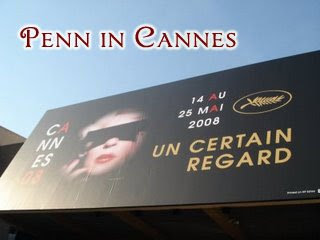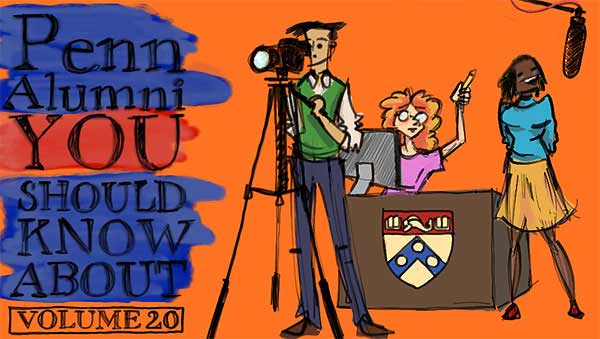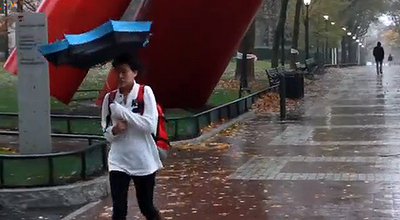Penn in Cannes: The Good, The Bad, and The Disappointing

 Felisha Liu (W’09) was part of a semester long Penn in Cannes program which had her and other Penn undergrads attending the festival last month.
Felisha Liu (W’09) was part of a semester long Penn in Cannes program which had her and other Penn undergrads attending the festival last month.
Before the program started, she shared with us two posts about her experience with the program thus far and what tactics she was going to consider in order to get into the most screenings while at Cannes.
Check back tomorrow as Felisha goes into more detail about her humbling experience of “begging” at the Cannes Film festival!
Friend Me Up:
![]() Facebook
Facebook ![]() MySpace
MySpace ![]() Friendster
Friendster  Twitter
Twitter  Digg
Digg
Per Felisha:
The Good
“The opening screening of the 61st Cannes Film Festival was Blindness. Cannes is a private festival for industry professionals. As such, the only way to get tickets to premiere screenings is to beg. The industry insiders are penalized for not using their allotment of tickets so they are looking to give away their tickets as such as I was looking to get one.After begging for over 5 hours, I got an Orchestra seat for the 11:30pm screening. The seats were perfect: 5 rows back and centered. In this film, Julianne Moore plays a dynamic leading role as the lone person with sight in a world struck with a sudden epidemic of blindness.
The first several hundred patients afflicted with the disease are quarantined in a makeshift prison. Soon after, human nature rears its ugly head and warfare erupts between different wards of the prison. Instead of the soldier guardsmen rationing the food, the despot of Ward Three decides to hoard the food in exchange for goods from the other wards.
The first day, the despot calls for money, jewelry and other items of value. The next time, he calls for the women from the other wards. After a ward-wide meeting, the women of Ward One decide to sacrifice their bodies in exchange for feeding the 35 people in their ward. The next scenes are disturbing shots of rape and abuse, which end with one woman dying at the hands of her abusers. As the plot progresses, Ward One manages to overthrow and kill many members of the tyrannical reign of Ward Three and escape from the prison.
But, ‘even when the blind are set free, they cannot run.’ Outside of the prison, the core group finds that more blind people are ravaging the city. Stores are ransacked and people fight over basic commodities like food and clothing. As the only person with sight, Julianne Moore’s character finds a secret store of food in the basement of a grocery store. Moral dilemma ensues, as she decides whether to let the other blind scavengers know, or to keep the knowledge to herself in the dog-eat-dog society. Corpses scatter across the city, as hungry dogs tear into rotting human corpses.
Julianne Moore’s character leads her friends into her home from before the epidemic. After serving as a martyr for months on end as the only leader, provider, nurse and eye for the group, something shocking ensues…but let this be a teaser for all those who will be seeing the film!
I really liked the movie for both its plotline and its cinematography. Lighting was very important in this movie about blindness. Throughout the film, the screen would turn all white whenever a character went blind. Julianne Moore’s character was the only one with sight, but she experienced the pain of blindness when she went into the dark cellar of the grocery store. Instead of turning all white, her character was blinded in a sea of darkness. It was a very ironic shot, and made a poignant statement about the importance of sight.
Human nature is very disturbing, but some parts of the film seemed unrealistic if this epidemic were to happen. The entire scene where Ward Three rapes the women of the other wards seems exaggerated and takes corruption to an unrealistic extreme. In real life, this would not likely happen because society functions on morals and value judgment. Even after losing sight, our society would likely still go on with established codes of behavior.”
The Bad
“I kept waiting in vain for Soi Cowboy (2008) to get better. Not knowing much about creative direction, I was impressed that the film was shot in black and white. Perhaps there was some powerful message that I was missing due to my own naivety. But as I looked around the theater, half the people were asleep and the other half looked miserable. People began filing out of the Debussy Theater in droves.I wasn’t about the give up on the film just yet, so I forced myself to delve deeper into the plot. But there was nothing there to grasp in this surface-level portrayal about a petite Thai girl and her obese, Danish boyfriend Toby. The girl seems more interested in his money than his unborn child. The hot/cold relationship leaves the audience confused and detached from either character. By not creating attachment between the audience and the characters, viewers have no obligations to jump the gaps in plot progression. One scene shows the girl crying in disgust after having sex with Toby. Another shot shows them staring lovingly into each other’s eyes in pure bliss. A third showed a different Thai girl lovingly hanging onto Toby with the original girlfriend looking on. Since nothing happened in between that would cause such a shift in affections, it just shows the disconnection between the director’s vision and what the audience experiences.
The most frustrating scene was of an old lady walk down the hallway in slow motion. The repetitive motion lasted for over 10 seconds. If that wasn’t bad enough, she turns around at the end of the hall and walks back down the hall for another 10 seconds. The scene made absolutely no contribution to the plot, and only made the audience angry for wasting their time.
In fact, the entire film was a waste of time. It felt like the Director was simply compiling an assortment of artistic techniques and inserting them in a lifeless screenplay, much like a schoolboy anxious to use all of his newfound classroom knowledge. Even when the film switched from black and white to color shots, there was no life. It was the same choppy, disjointed scenes, just brighter. It is easy to understand why this movie could never make it in the American theaters.”
The Disappointing
“I did the impossible—I got into the first screening of Indiana Jones and the Kingdom of the Crystal Skull.The buzz around Cannes was mounting for a week before the main attraction of the Festival. Indy fever was raging strong across the town. The majestic Carleton Hotel entrance was adorned in Indy attire as enormous banners enveloped the façade of the building. It was hard to miss the huge amount of advertising money that the studio spent on promoting this film. From previous experiences with begging for tickets, I told myself that I would not even try for Indy tickets. It would be a waste of time in the blazing sun and I would miss out on watching other movies.
But when Sunday came around, I went downtown early in the day line up for the Cinephile tent.
After securing tickets for later that night, my classmate Anna Cororaton and I had nothing else to do. With nothing to lose, we took out loose-leaf paper and made signs for Indy. The front of the Palais was crowded with people seeking tickets so we distanced ourselves away from other people. Anna went across the street while I sat in my usual spot on the street divider. An hour passed with no luck. The harsh midday sun started to blur my vision. All of a sudden, Anna ran over with an Indy ticket in her hand. That was great, but I was still without a ticket. We resumed the sign holding for another hour to get a ticket for me.
Half an hour before the doors closed, a woman came up and nonchalantly handed me an orange folded ticket. At first I was in disbelief because I never thought I would be able to get in. I thanked her profusely in both English and French, hoping she would be able to receive my gratefulness at least in one language.
The 1pm screening lacked the star-studded affair of the nighttime screening, but the excitement inside the Lumiere Theater was not dampened. The applause was thundering as soon as the all-too-familiar Cannes theme song appeared on-screen. The audience went wild when Spielberg’s credit appeared.
Unfortunately, the movie did not live up to its expectations from excessive marketing. The story plot was too coincidental, and overly predictable. With George Lucas’ influence on the movie, there had to be aliens somewhere in the film. The problem was it didn’t flow well with the rest of the movie. A huge divide exists between the first part of the film and when Indy reaches the Crystal Skull room. My expectations for Indiana Jones are about quick reflexes, rugged strength and clever problem solving. Adding supernatural features dilutes the authenticity of the saga. I could easily see Lucas’s influence in developing the second half of the film. There are extreme levels of computer animation and less emphasis on actor skill. Some of the shots definitely had the feel of the Star Wars series. After rustic images of trekking through the jungle and sword fighting atop jeeps, it seems bizarre that aliens would leave in a high-tech spaceship. Overall, I liked the first part of the film much better because it brings back the nostalgia of the Indy series.”
Advertise on DT | Get the newsletter! | Join the DT Facebook Group!
Join the DuelingTampons Facebook Group!
See which Penn undergrads and alumni are registered on DuelingTampons.comCheck out our 1000+ Penn videos
Submitting a story to Dueling Tampons: What you need to know…














